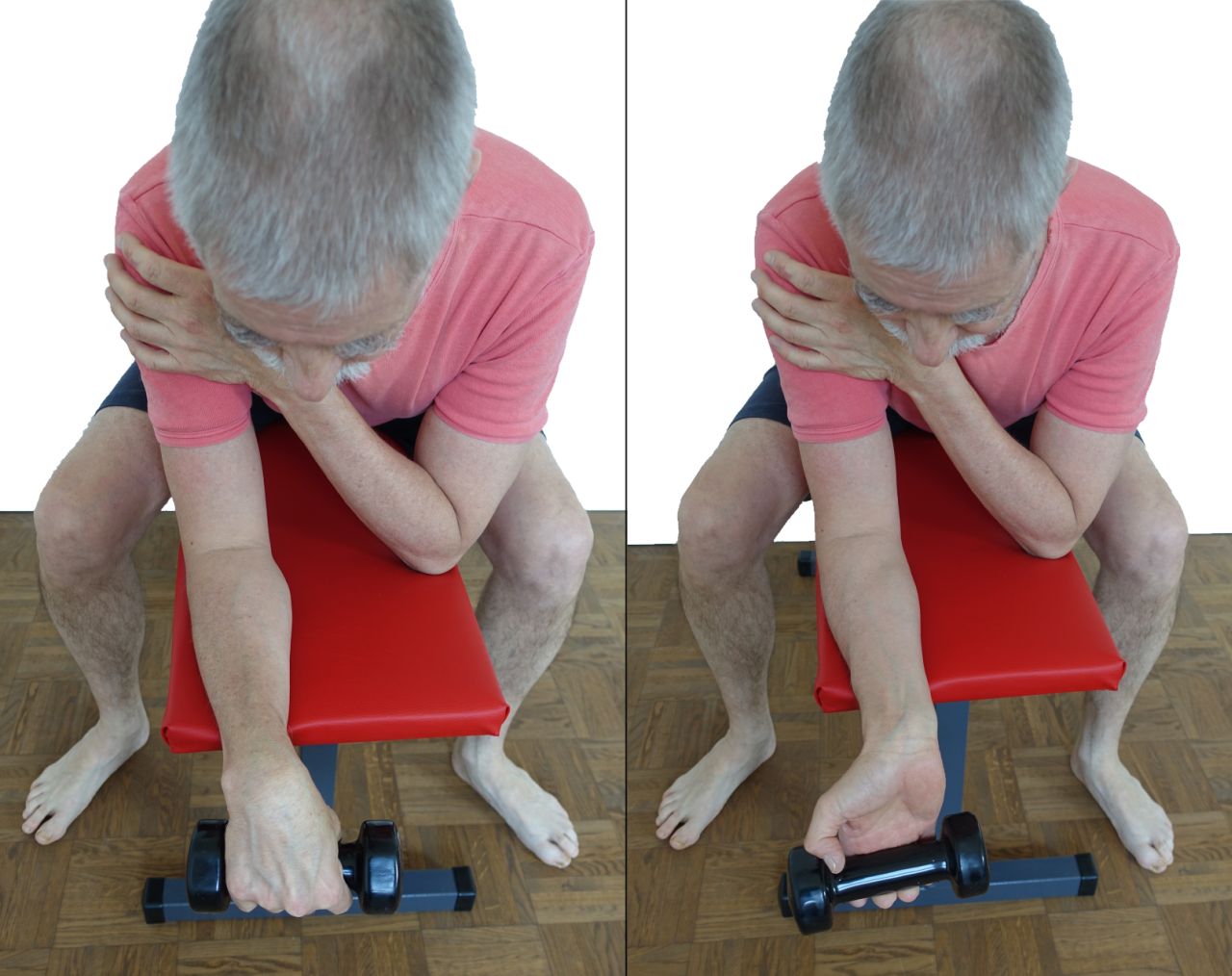yogabook / functional exercises / practicing palmar flexion and dorsiflexion of the wrist
Contents
practicing palmar flexion and dorsiflexion of the wrist

Feedback: We would love to hear what you think about this description, give us feedback at:
postmeister@yogabook.org
last update: 30.10.2023
Level: A
- Classification
- Contraindication
- Effects
- Preparation
- Follow-up
- derived asanas
- similar asanas
- Diagnostics
- Instructions
- Details
- Variants
Classification
Functional exercise
Contraindication
In the case of a golfer’s elbow, a special procedure described below applies to the execution of palmar flexion; the same applies to dorsiflexion in the case of a tennis elbow.
Diagnostics
Pain during dorsiflexion of the wrist on the lateral epicondyle of the humerus may indicate tennis elbow. If there is also tenderness of the lateral epicondyle, this is quite likely. Muscle origins affected by dorsiflexion may be those of the following muscles: extensor carpi radialis brevis, extensor carpi ulnaris, extensor digitorum, extensor digiti minimi.
If pain occurs at the medial epicondyle of the humerus during palmar flexion of the wrist, this may indicate golfer’s elbow, especially if the medial epicondyle is also painful. Muscle origins affected by palmar flexion are those of the following muscles: Flexor carpi radialis, flexor carpi ulnaris, palmaris longus, flexor digitorum superficialis
Note that mixed types of golfer’s elbow and tennis el bow are not uncommon. It is also possible for both disorders to occur simultaneously.
Instructions
- Sit on the floor and place your forearm horizontally in front of you on a suitable elevation such as a weight bench, two or three flat stacked blocks or an appropriate number of shoulder support plates so that your wrist can move freely. If no aid is available, this can also be your own thigh in a seated position.
- Take a dumbbell of suitable weight in the lower grip and bend the wrist alternately
a) maximally palmar to the limit of flexibility or before the onset of a cramp tendency
and
b) dorsally to the limit of flexibility or until the sensation of too intense stretching occurs. Towards the end of the dorsiflexion, allow the finger flexors to become increasingly passive until the dumbbell rests only on the distal phalanx, just before the fingers slip away.
Details
- Depending on the tone of the muscles flexing the wrist, a cramp-like sensation can occur in the performing muscles during palmar flexion. This can be caused by the extrinsic finger flexors or the non-finger flexing flexores carpi. Of course, the exercise should not be practiced to the point of intense cramping, both in terms of the angle of palmar flexion and the force required for this and the duration of the hold.
- With dorsiflexion of the wrist( dorsalflexion, i.e. on the back of the hand, often also referred to as extension / dorsiflexion), there are basically several possible limits to execution:
(a) lack of strength to hold the position or a more advanced one
b) the soft-elastic, i.e. muscular movement limit, which is given by the stretching capacity of the antagonistic muscles, i.e. the finger flexors and the non-finger flexor palmar flexors.
c) Cramp-like sensation in the finger extensors
d) Depending on the disposition, a firm-elastic movement limit is also reached with very low muscle tone and good flexibility. - Depending on the strength and tone of the various finger flexors and extensors, the wrist may also move into radial abduction or ulnar abduction, although the latter is much more likely. Try to move the wrist as free as possible from parts in this dimension of movement.
- If the tone of the finger flexors and wrist palmar flexors is high, the holding time in both positions should be shifted significantly in the direction of wide dorsiflexion.
- Sometimes a more or less pronounced displacement in the wrist in the palmar-dorsal axis is seen under the load of the muscles performing the movement, which indicates a mostly ligamentous instability in the wrist and requires clarification depending on the extent and movement profile of the person.
- In the case of golfer’s elbow or tennis elbow, the relevant pain can be triggered at the medial epicondyle or lateral epicondyle of the humerus. As with the other two exercises for the movements in the wrist(forearm (practicingpronation and supination of the arm and practicingradial abduction and ulnar abduction), you can test for 10 to 30 seconds whether the pain subsides when the triggering position is held isometrically. If this is the case, this can be done up to three times a day with a pain intensity of NRS 6-8; the rest of the rehabilitative training should be done in the range of NRS 2-3 at most.
